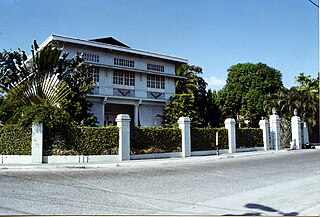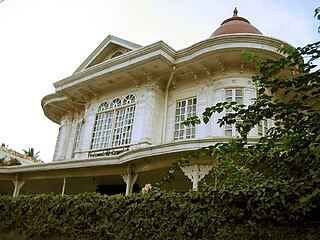
San Fernando, officially the City of San Fernando, is a 3rd class component city and the capital of the province of La Union, Philippines. It is a coastal city consisting of fifty-nine (59) barangays and covers an area of 105.26 square kilometers. According to the 2020 census, the city has a population of 125,642. San Fernando serves as the gateway to trade and commerce to the North and the culture and heritage of Ilocandia.

Hidalgo is a station on Line 2 and Line 3 of the Mexico City Metro system. It is located in the Cuauhtémoc borough of Mexico City, west of the city center, on Hidalgo Avenue and serves the Colonia Tabacalera, Colonia Guerrero, and Colonia Centro districts.

Paco, formerly known as Dilao, is a district of Manila, Philippines, located south of the Pasig River and San Miguel, west of Santa Ana, southwest of Pandacan, north of Malate, northwest of San Andres Bukid, and east of Ermita. According to the 2020 census, it has a population of 79,839 people.

The Archdiocese of Manila is the archdiocese of the Latin Church of the Catholic Church in Metro Manila, Philippines, encompassing the cities of Manila, Makati, San Juan, Mandaluyong, Pasay, Taguig, and Quezon City. Its cathedral is the Minor Basilica and Metropolitan Cathedral of the Immaculate Conception, also known as the Manila Cathedral, located in Intramuros, which comprises the old city of Manila. The Blessed Virgin Mary, under the title Immaculate Conception, is the principal patroness of the archdiocese.

San Fernando, officially the City of San Fernando, is a 1st class component city and capital of the province of Pampanga, Philippines. According to the 2020 census, it has a population of 354,666 people.

The College of Liberal Arts (CLA) of De La Salle University, formerly known as the College of Arts and Sciences was founded in 1918. In 1982, the College of Arts and Sciences was split into two colleges, the College of Liberal Arts, and the College of Science. The CLA provides Lasallians with a liberal education enough to develop the student in humanities and the social sciences. The college is now the most populous in the university, following the split of the College of Business and Economics into the College of Business and the School of Economics in 2010. The CLA Administration is located in 2nd floor of the Miguel Hall. The Departments of Literature and English are both recognized by the Commission on Higher Education as Centers of Excellence.

The Hizon-Singian House is a Bahay na Bato heritage house located in the City of San Fernando, Pampanga. Built in 1870 by the couple Don Anacleto Hizon, gobernadorcillo of San Fernando from 1877-1879 and 1886-1887, and Victoria Singian de Miranda y de Ocampo. Inherited by their daughter Victoria Hizon y Singian who was married to Godofredo Rodriguez y Yabut from Bacolor. It was occupied during the 1896 revolution by Spanish General Antonio Ruiz Serralde, appropriated by the Japanese Imperial Army to serve as a military hospital and barracks from 1943 to 1944, and served as headquarters of American General Walter Krueger of the 6th American Army during the liberation period until the end of 1945. Inherited by their son, the late Gerry Catalino Rodriguez Y Hizon, former president of the Pampanga Sugar Development Company (PASUDECO), who was married to Aurora Angeles. This bahay na bato of the Spanish colonial period was declared a Heritage House by the National Historical Institute on 27 January 2003 by virtue of Resolution No. 4, S. 2003.

The Lazatin House is one of the two heritage houses owned by the Lazatin family in the City of San Fernando, Pampanga province in the Philippines.

The Augusto P. Hizon House is a heritage house in the City of San Fernando in the Pampanga province of the Philippines. The house is located along Consunji Street in the city.

The Pampanga Hotel is a heritage house in the City of San Fernando, Pampanga in the Philippines.

The City Hall of San Fernando, Pampanga, commonly referred to as Municipio de San Fernando, is a heritage building of the City of San Fernando, Pampanga province, Philippines.

San Fernando station is an under-construction elevated North–South Commuter Railway (NSCR) station located in San Fernando, Pampanga, Philippines.

The Diocese of Balanga is a Latin Church diocese of the Catholic Church in the Philippines, established on March 17, 1975, by Pope Paul VI. The diocese has jurisdiction over the whole province of Bataan, with 38 parishes, 5 diocesan shrines, one minor basilica, chaplaincy, quasi-parish, national shrine and chapel, and 4 vicariates. The Cathedral-Shrine Parish of St. Joseph, Husband of Mary in Aguire Street, Poblacion, Balanga, serves as the seat of the diocese. It is part of the Ecclesiastical Province of San Fernando, Pampanga. The titular patron of the diocese is Saint Joseph, whose feast day falls on March 19. The city fiesta is celebrated on April 28.

The Archdiocese of San Fernando is the archdiocese of the Latin Church of the Catholic Church in Pampanga, Philippines which has territorial jurisdiction over the whole province of Pampanga and Angeles City. The archdiocese is also the metropolitan see of the ecclesiastical province of the same name, which also include three dioceses of its surrounding provinces of Bataan, Zambales, and Tarlac. The cathedral church and seat of the archdiocese is the Metropolitan Cathedral of San Fernando (Pampanga). The Virgin Mary, under the title Virgen de los Remedios, is the principal patroness.

The Diocese of Iba is a Latin Church ecclesiastical jurisdiction or diocese of the Catholic Church in the Philippines that comprises the province of Zambales and City of Olongapo.

Colonia Tabacalera is a colonia or neighborhood in the Cuauhtémoc borough of Mexico City, on the western border of the city's historic center. It was created in the late 19th century along with other nearby colonias such as Colonia San Rafael and Colonia Santa María la Ribera. From the early 1900s, it became a mixture of mansions and apartment buildings, with major constructions such as the now Monument to the Revolution and the El Moro skyscraper built in the first half of the century. By the 1950s, the area had a bohemian reputation with writers, artists, and exiles living there. These included Fidel Castro and Ernesto “Che” Guevara, who met each other and began planning the Cuban Revolution there. Today, the colonia is in decline with problems such as prostitution, crime, street vending and traffic. However, the area is still home to some of the many traditional Mexican cantinas that populated it in its heyday.

The Monumento Encuentro refers to two bronze statues seated on a bench in Colonia Tabacalera, Cuauhtémoc, Mexico City, designed by Óscar Ponzanelli in 2017. Otherwise known as the bench of Fidel Castro and Che Guevara and the statues of Fidel Castro and Che Guevara, the artwork features sitting statues of Fidel Castro and Che Guevara, major figures of the Cuban Revolution (1953–1959). The monument references the first time both met in 1955 in Tabacalera.

Naval Base Lingayen was a United States Navy base built during World War II at Lingayen Gulf on the northwestern Island of Luzon in the Philippines. The base was founded after the Invasion of Lingayen Gulf on January 9, 1945, at Lingayen city and the surrounding gulf. The Naval base was used to support the later operations at Manila and the rest of Luzon Island and then at Okinawa. Lingayen Gulf offered excellent fleet anchorage.

The former Saint Ferdinand Barracks in Pontevedra, is a large neoclassical building from the beginning of the 20th century located in the centre of Pontevedra (Spain), opposite the Doctor Marescot Gardens and very close to the Alameda de Pontevedra.






















